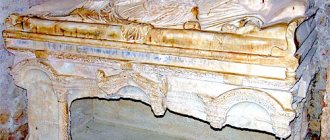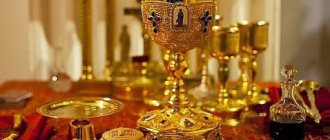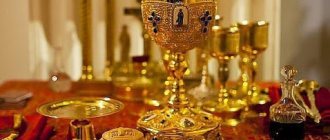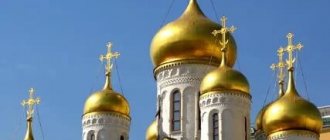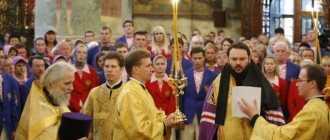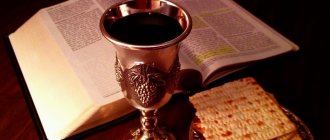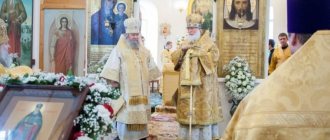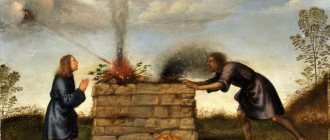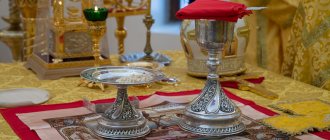Holy Chrism
[1] (in pre-revolutionary spelling
mvro
; Old Slavic mouro; Greek μύρον; Arabic murr) - an fragrant composition of many aromatic substances, used for sacred rites in the Church since Old Testament times.
In a broader sense - and other fragrant substances.
For the composition brought by pious women to anoint the body of Christ, see myrrh-bearers ;
about the miraculous substance exuded by holy relics and icons, see myrrh flow
. It is used in the sacrament of anointing, for the consecration of antimensions and altars of churches; Previously, it was also anointed for the kingdom of sovereigns. Anointing with holy myrrh is an external sign of the teaching of the gifts of the Holy Spirit to the anointed one, and therefore the abundance of the components of the world symbolizes the diversity of Christian virtues. The Holy Chrism is prepared and consecrated once every few years by some of the primates of the autocephalous Churches, and from them it is passed on to the bishops and priests of the Orthodox Church throughout the world. The vessel with presanctified myrrh, alavaster, kept in the autocephalous Churches is a symbol of apostolic succession.
What is myrrh?
The word " mirror
" in church usage has several meanings.
• This is the name given to the liquid that miraculously emanates from some icons
and relics
of saints.
The origin of the miraculous world cannot be explained scientifically. As a rule, it is oily and exudes an unearthly fragrance. In this way, God visibly reveals His grace
.
• Sometimes the world is called incense with an arbitrary composition, which is consecrated at Christian relics and then offered to pilgrims. These incense are reminiscent of the ointment with which the woman mentioned in the Gospel anointed the feet of the Savior, as well as the fragrant composition with which the myrrh-bearing wife wanted to anoint the body of Christ.
• The world is also called a complex composition, which is prepared and consecrated by His Holiness the Patriarch once a year. This is the world we will focus on in this section of our guide.
The composition of the liturgical world and the procedure for making world peace
The preparation of peace in the Orthodox Church is strictly regulated. It occurs during Lent and lasts for several weeks. The composition of this substance includes about fifty components, including fir (olive oil), white wine, incense, rose petals, rose, lemon and clove oils, etc. On Wednesday of the Week of the Cross, a special prayer service is held. Then all the components of the world are mixed and left to infuse until the beginning of Holy Week. On Maundy Monday, the myrrh is placed on low heat and cooked for three days without interruption. All this time the priests read the Gospel over him. Upon completion of cooking, on Maundy Thursday the myrrh is consecrated by His Holiness the Patriarch. A little of the old is certainly added to the newly brewed myrrh - this is how continuity from apostolic times is maintained.
Features of use
The myrrh boiled and consecrated by the Patriarch is distributed to parishes and monasteries - this ensures the spiritual unity of all churches, all members of the Russian Orthodox Church. It turns out that all believers accept grace through peace received from the Primate of the Church - the Patriarch. And he, in turn, received it through a long series of predecessors from the apostles themselves.
In the temple, the myrrh is kept on the throne, in a special vessel - the myrrh.
Anointing
This is not a sacrament, but a rite - the priest inscribing a cross on the forehead of believers with consecrated oil, performed at the service of Sunday and holiday matins after reading the Gospel, during the veneration of the icon of the holiday, placed in the middle of the temple on a lectern.
It is wrong to leave the service after receiving anointing, and also to come to the service only at the time of its completion. At this time, the singing and reading of the canon of the celebrated event begins, revealing the meaning and essence of the holiday, therefore, as soon as the priest or bishop anoints with oil, you need to step aside, stand in the same place in the church and reverently listen to what they sing and read.
Unfortunately, sometimes parishioners start conversations, united in groups, greet noisily, kiss the icons and completely miss the saving words of the festive canon. But anointing with oil is not a central part of the divine service, and previously they anointed with oil only at the altar and only clergy.
It is also wrong to require the priest to anoint with oil when the service has already ended. If you were late for the service, did not have time to anoint yourself with oil, find the courage to humble yourself, ask the Lord for forgiveness and continue to try not to be late.
Application of liturgical peace
Most often, myrrh is used to perform the Sacrament of Confirmation, which usually follows Baptism. With a special prayer, the priest anoints the forehead, hands, feet, chest, lips, eyes, ears and nostrils of the newly baptized, calling upon him Divine grace with the words: “ The seal of the gift of the Holy Spirit.”
Amen ." Confirmation should not be confused with another Christian Sacrament - Blessing of Anointing (Unction), as well as with the ritual of anointing with oil, which is performed at the All-Night Vigil. The Sacrament of Confirmation is performed on a person only once in a lifetime.
Myrrh was also used during anointing for the kingdom. This action called upon the monarch a special grace, helping him to rule the state not only with his own, but with Divine power and wisdom. Therefore, the king was called God’s anointed, and rebellion against him was considered a great sin, which excommunicates the person committing it from the Church. Therefore, the rebels (Stenka Razin, Emelka Pugachev) were declared “anathema” along with the ancient heretics. By the way, anathema is not a curse, but a statement of the fact that a certain person, through his sins, separated (excommunicated) himself from the Church, just as its dried leaves fall off a tree.
Finally, the throne and walls of the consecrated temple are anointed with myrrh. In accordance with this, the temple ceases to be an ordinary building and becomes the House of God, to desecrate or destroy which is a terrible sin. It is believed that when the temple is consecrated, a Guardian Angel is given who will stand in the place of its altar until the end of the world, even if the temple is destroyed.
The Sacrament of Unction, or Blessing of Anointing
This is one of the seven sacraments of the Church, consisting of priests anointing a sick person with consecrated oil, with the reading of the Gospel, the Apostle and prayers invoking Divine grace. The forehead, nostrils, cheeks, lips, chest, outer and back of the hands are anointed in a cross shape.
The Sacrament of the Blessing of Anointing was established by the Lord Jesus Christ and was performed already in apostolic times. It serves as a grace-filled healing for physical and mental ailments and grants the patient forgiveness of forgotten, unconfessed sins. The oil in the sacrament signifies the mercy of God, and the wine added to it in small quantities signifies the atoning Blood of the Savior.
The Sacrament of the Blessing of Anointing is performed in churches during Great Lent for all those who are sick; the rest of the time, the priest can be invited to the sick person’s home. The opinion that unction can only be performed before death is erroneous and comes from Catholic church practice.
It is not always possible to see that a patient who has begun the Blessing of Unction receives the desired recovery. Several explanations can be given for this. Firstly, health is a temporary benefit for humans, since the corruption of human nature itself presupposes the inevitability of physical death. To always desire healing from illness would be to demand for oneself the opportunity to never die. Such a desire is contrary to the very plan of our restoration, according to which we need to lay off this sinful, dead body in order to put on the immortal.
Secondly, even if the effect of the sacrament does not result in complete recovery, it can alleviate the suffering of the patient for a while. The absence of healing can also be a consequence of insufficient faith in the person approaching the sacrament or, on the contrary, a special action of God’s providence for him. There are known cases when, after the Blessing of Anointing, people who were in a painful and long illness were delivered from their suffering through a quiet and bright death, granted, undoubtedly, through the action of the sacrament.
But the most accurate explanation would be that bodily healing is not the main or most important effect of the Sacrament of Anointing. The effect of grace also affects the moral state of a person’s soul: “And if he has committed sins, they will be forgiven him.” According to the apostle, a person lying on an illness bed needs not only physical healing, but also forgiveness of sins - illness and sin are interconnected. The Apostle James himself writes about this connection at the beginning of his epistle: Sin committed gives birth to death (James 1:15). Just as death and corruption of human nature is a consequence of the Fall, so a person’s personal sins can be the cause of aggravation of the disease.
There is a custom: first to confess, then to receive unction, then to receive communion, because no sacrament is complete without communion of the Holy Mysteries of Christ. It is necessary that those people who often confess, often receive communion, and live the church life take part in unction.
From the history
The Old Testament narrates that God commanded Moses to make myrrh for sacred anointing, and his recipe is given: “... pure myrrh five hundred shekels, fragrant cinnamon half as much as two hundred and fifty, fragrant cane two hundred and fifty, cassia five hundred shekels, according to the holy shekel, and olive oil; and make of this myrrh for holy anointing
." (Ex. 30:22-25). The Old Testament tabernacle was anointed with this ointment during the consecration. Anointing a person with myrrh was done when he was assigned to some special ministry given by God. Moses anointed his brother Aaron to serve, and then the prophets and kings entering the field were anointed with myrrh.
In the Gospel we read about how a certain woman anointed the Savior’s feet with myrrh. Of course, this was not a sacred temple incense, but some kind of aromatic composition that could be used in everyday life. Its origin is also mentioned: myrrh is called backgammon
. Nard is a plant native to the Himalayas. The incense from it was highly valued, so its libation was a sign of deep reverence and veneration.
Finally, at the burial, the Body of Christ was anointed with incense in accordance with the burial custom practiced at that time. Myrrh-Bearing Women
, considering that this was not enough, they bought more precious ointment and wanted to anoint the Savior with it on the third day after His placement in the tomb, but Christ was resurrected.
Healing with oil, holy oil
When you are sick, you cannot be discouraged and despair. If you are faced with an illness, especially if the symptoms of the illness are dangerous, order a prayer service for health in the temple. This is a short service performed by a clergyman. On behalf of the entire Church, earthly and heavenly, he prays for the one who ordered the prayer service. Of course, such powerful prayer has a special grace.
It is useful to order a prayer service for the health of the sick to the holy healers in the church, ask them to bless the oil at the prayer service, and after the service take the blessed oil. After the prayer, the patient or relatives can show his forehead in a cross shape with holy oil, dipping a clean brush or finger into it. Also, if you are sick in the morning, on an empty stomach, make it a rule to drink holy water and eat part of the prosphora (church unleavened bread with a seal from a cross on a flat top, from which particles are taken out with the names of people remembered; the prosphora will be given to your loved ones or to you when submitting a note “Oh health" for the Liturgy, which also needs to be done for you if you are sick). with the prayer “Lord, bless!” Or “Lord, my God, may your holy gift be to me: prosphora and holy water for the forgiveness of my sins, enlightenment of my mind, strengthening of my mental and physical strength, health of my soul and body, deliverance from my vices and illnesses according to your infinite mercy and the prayers of Your most pure Mother and all Your saints. Amen". Holy water and blessed oil can also be added to food. For example, if your spouse or relative is not a believer, you can add water and oil while cooking with prayer.
Place icons of the Lord, holy healers - St. Luke of Crimea, Panteleimon the Healer and the Blessed Virgin Mary - next to the bed. Pray often. When sick, a person must heal and pray at the same time. This is a time of reflection about your life, not only ordinary, but also spiritual, about the state of your soul - after all, it is impossible to do business at this time or it is very difficult. Prayer is communication in silence with God, Who admonishes us.
In turn, medication and other treatment prescribed to you by your attending physician is your concern for yourself. After all, if you are treated only by prayer, you seem to force God to perform a miracle. And this is unacceptable: you yourself must make efforts to recover.
Symbolism
In Christianity, liturgical chrism
is the bearer of grace, which is passed on in the Church from generation to generation, starting from the apostles. The Book of Acts of the Holy Apostles tells how the Holy Spirit descended on the first disciples of Christ in the form of tongues of fire. This event became the birth of the Church: the gathering of believers was granted power from God - grace. When performing Baptism, the apostles laid hands on new Christians, transferring this grace to them. The apostles also laid hands on those whom they ordained to the priesthood - which is why this dedication is still called ordination in Russian today.
With the increase in the number of people wishing to be baptized, the apostles could no longer lay hands on everyone. Instead, they blessed the myrrh, with which the clergy began to anoint the newly baptized. This is how the Sacrament of Confirmation appeared, which is still celebrated in the Church today.
